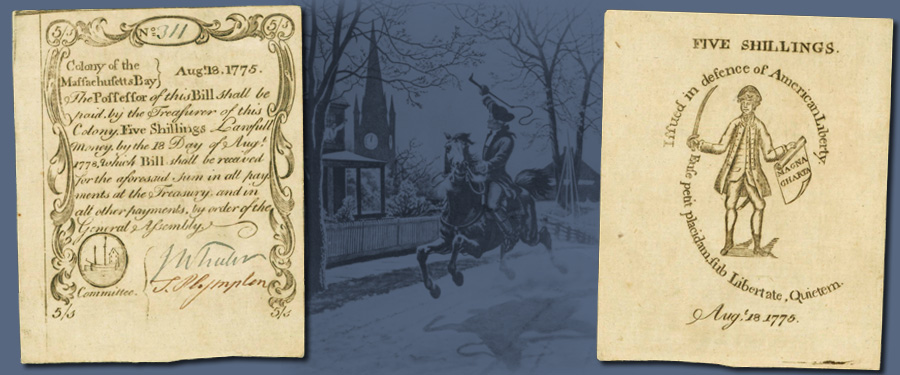
With last weekend’s celebration of the Fourth of July holiday we look at one of the most patriotic issues of notes in American history. Before the first federal issues of American currency were produced, the colonies printed their own circulating paper currency. The Massachusetts Bay Colony issued a series of notes in 1775 and 1776 printed by famous American patriot Paul Revere.
Revere, who is popularly remembered for his “Midnight Ride” through Lexington and Concord in April 1775 to warn colonists of approaching British troops, engraved copper plates and printed notes of various denominations for the colony. The back of the notes featured a patriot standing with a sword in his right hand and a scroll with the words “MAGNA CHARTA” in his left. Above him is the inscription “Issued in defence of American Liberty.” The motto “Ense petit placidam, sub Libertate, Quietem,” (By arms he seeks peace with freedom) runs from the base of the sword to down below the patriot. This design is an iconic depiction of American patriotism in the fight for independence against the British crown.
The first “Sword in Hand” notes were dated August 18, 1775 and issued in denominations ranging from 1 shilling through 40 shillings. Revere charged the colony 6 pounds for each copper plate he produced and 72 pounds 6 shillings and eight pence per 1,000 impressions printed.
Like many colonial issues, the “Sword in Hand” notes were heavily counterfeited and numerous variations made it extremely difficult for the public to determine which notes were authentic. After just two years the notes began to be pulled from circulation and replaced. Today, these notes are in high demand due to their iconic design and famous pedigree to Paul Revere. Illustrated is lot 3022 from the Stack’s Bowers Galleries Official Auction of the August 2013 ANA World’s Fair of Money. That impressive August 18, 1775, 5 shillings note was graded PCGS Choice New 63 PPQ and realized $70,500.





